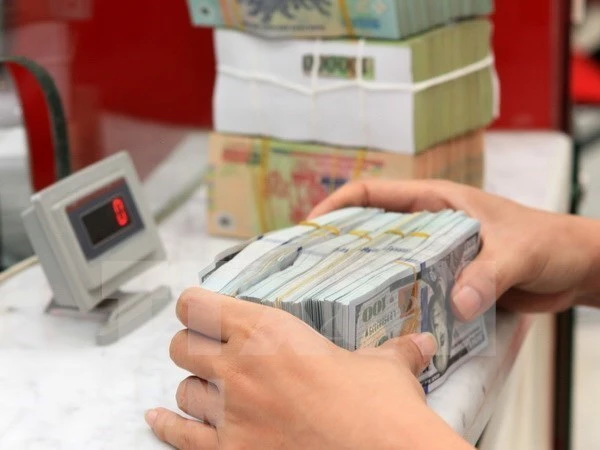
While export-oriented companies benefit from the exchange rate variations, those that have borrowed capital in USD face the risk of incurring exchange rate losses. This situation has led to different outcomes for various businesses, influencing their financial performance.
Is the exchange rate still fluctuating?
The central exchange rate between VND and USD, as determined by the State Bank, recently reached an all-time high of 24,063 VND/USD. Commercial banks are permitted to trade with a margin of 5%, resulting in a ceiling exchange rate of 25,229 VND/USD and a floor exchange rate of 22,400 VND/USD. Consequently, the VND has depreciated by more than 3% compared to the beginning of the year.
According to forecasts from Vietnam Treasury Securities Company (KBSV), exchange rate pressure is expected to persist until the end of the year due to three main factors: a significant difference between USD and VND interest rates, the ongoing strengthening of the USD, and increased import demand driven by economic recovery. KBSV predicts an exchange rate increase of about 3.5% compared to the beginning of the year, reaching VND 24,460 by year-end. Exchange rate pressure is likely to limit the downward trend in interest rates, although the VND's devaluation remains relatively controlled compared to other economies.
Rong Viet Securities Company (VDSC) suggests that the State Bank can continue to issue bills to manage the exchange rate. However, this should not be mistaken for a reversal in monetary policy, as money supply regulation is still flexible and timely. The effectiveness of interventions in managing exchange rate pressure depends on several factors, primarily the USD index's trend. A significant risk is the possibility of the USD index surging to 110, which may necessitate State Bank interventions, including foreign currency sales, to maintain the exchange rate at this level until year-end.
Businesses facing difficulties
Exchange rate fluctuations have produced contrasting effects on the production and business activities of listed companies. Businesses with foreign currency revenue from exports, such as textiles, seafood, footwear, electronics, agricultural products, rubber, and wood, have benefited from the USD/VND exchange rate increases. On the other hand, companies that have borrowed in USD and those with substantial USD-denominated debt are adversely affected by USD appreciation, leading to exchange rate losses. This has resulted in reduced profits for businesses with USD-denominated liabilities.
The impact on each business depends on their specific circumstances. Those generating revenue in USD or benefiting from exchange rate differences with other foreign currencies may balance out their exchange rate losses. Companies importing raw materials in dollars face challenges due to rising USD prices, and this leads to higher costs for imported Vietnamese goods, potentially affecting their profits.
At the end of 2022, the listed company with the largest USD-denominated loan was VIC (VND 88,841 billion), followed by PGV (VND 35,397 billion), NVL (VND 23,187 billion), and others. The more than 3% increase in the USD/VND exchange rate since the beginning of the year has had a negative impact on the pre-tax profits of these businesses. For example, estimated profit decreases for several businesses include QTP (down 75.7%), PGV (down 38.5%), VIC (down 23.2%), and NVL (down 19.4%).
Additionally, these businesses have incurred additional losses due to exchange rate differences, with VIC reporting a loss of VND 2,955 billion, PGV a loss of VND 1,177 billion, NVL a loss of VND 771 billion, and others suffering similar losses.
No significant impact on the stock market
Interestingly, despite the forecasted impact of exchange rate fluctuations, most of the stocks of these businesses have maintained their stability, with many even defying the general downward trend in stock prices. For example, businesses in the thermal power and oil and gas industries, both of which have significant USD loans, continue to perform well. Investor expectations of a potential recovery or favorable prospects in the last months of the year have played a significant role in supporting these stocks.
Taking thermal power enterprises as an example, despite being particularly susceptible to exchange rate fluctuations, they are expected to benefit from the ongoing El Niño phenomenon, which is forecasted to persist into 2024. This phenomenon will affect the production output of hydropower plants, especially during periods of peak heat and low water levels. As a result, thermal power plants will be mobilized to compensate for the shortage in electricity supply, particularly in northern regions where alternative power sources are limited. Additionally, cooling coal and gas input prices will have a positive impact on this industry.
This contrasting effect on the financial performance of businesses demonstrates the importance of exchange rate management and its influence on the Vietnamese stock market.




















